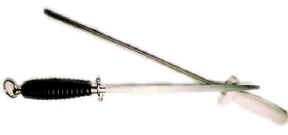 A
sharpening steel works on a very fundamental principle. Quite simply, it
provides a grinding surface that is harder than the blade of the knife to
be sharpened; this allows sharpening to take place. For this reason, you
must be sure that the steel has a higher Rockwell Scale* number than the
knife. Most chefs' knives are in a range of 54 to 57 and most steels are
between 64 and 67. The surface of a sharpening steel can be finished or
"cut" several different ways: Course Spiral Cut, Precision Cut,
Polished Finish, and Doublesharp.
A
sharpening steel works on a very fundamental principle. Quite simply, it
provides a grinding surface that is harder than the blade of the knife to
be sharpened; this allows sharpening to take place. For this reason, you
must be sure that the steel has a higher Rockwell Scale* number than the
knife. Most chefs' knives are in a range of 54 to 57 and most steels are
between 64 and 67. The surface of a sharpening steel can be finished or
"cut" several different ways: Course Spiral Cut, Precision Cut,
Polished Finish, and Doublesharp.
The sharpening steel that is used depends upon the
sharpening job at hand. It is recommend to own both doublesharp and
precision cut steels to ensure that you have the proper tools available
when you need them.
The size and shape of the steel will vary depending upon
the need of the user. Sharpening steels come in lengths ranging from three
to fourteen inches (7.5 cm to 36 cm). As a rule, a steel should be at
least as long as the length of the knife blade being sharpened. Sharpening
steels can be round or oval. Round sharpening steels are generally
preferred, while oval-shaped sharpening steels provide a larger sharpening
surface.
A sharpening steel may become soiled through use and
develop a grease barrier. This grease barrier will prevent the steel from
"biting" and the knife will not be sharpened properly. To avoid dirt
build-up, wash the sharpening steel regularly in hot sudsy water and dry
immediately to avoid rusting. Polypropylene handles may be sterilized by
boiling the handle in water.
*The Rockwell C Scale is an indicates the hardness of
materials. The higher the number, the harder the material.


